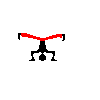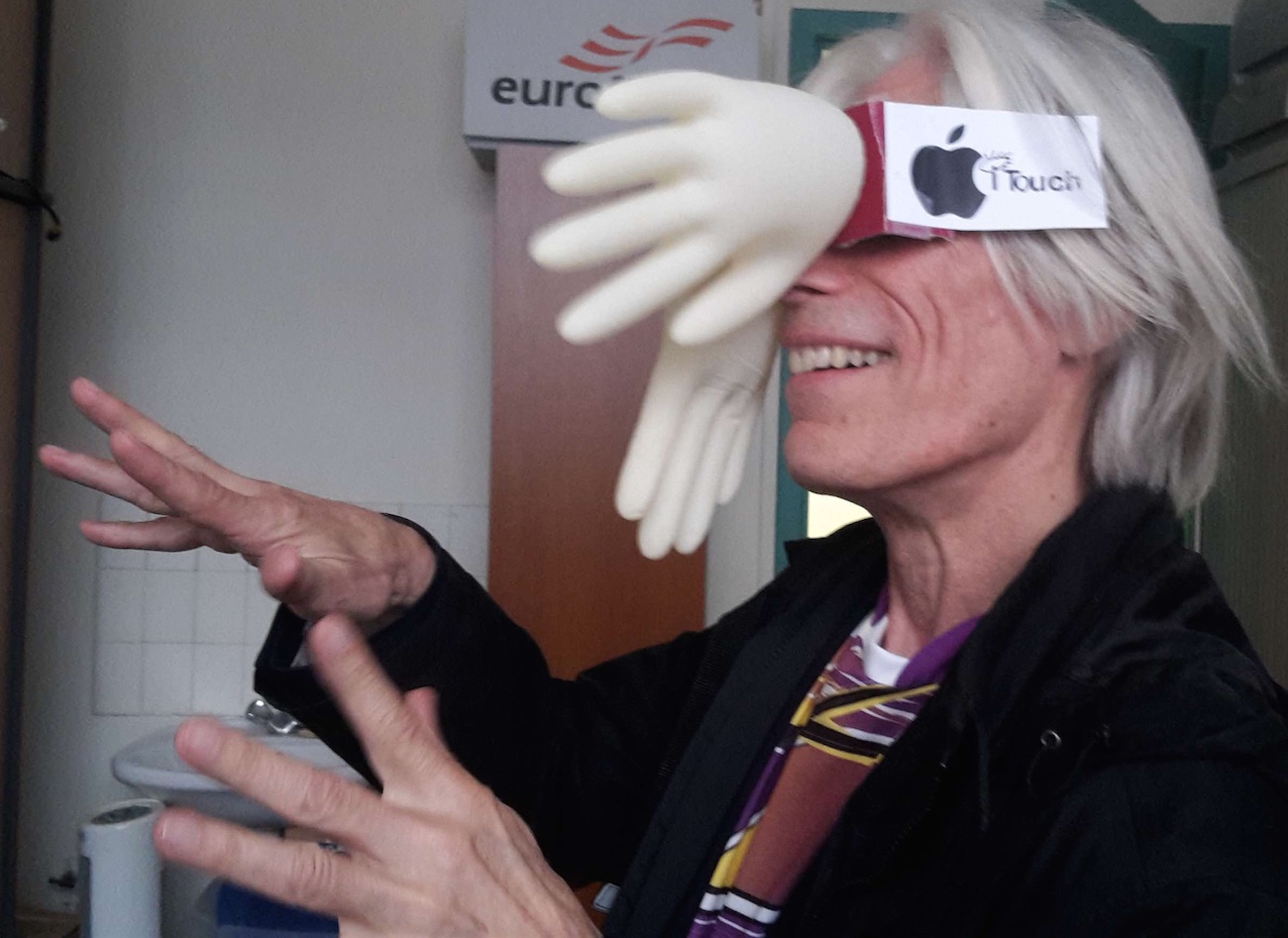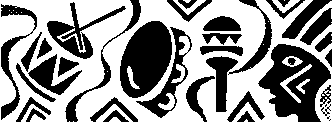Download the last draft of my book with OUP 2011 ("Why red doesn't sound like a bell")
ERC Advanced project "FEEL" website
PAST RESEARCH
CURRENT RESEARCH
CHANGE BLINDNESS DEMOS
PAPERS
J.
Kevin O'Regan
Laboratoire Psychologie de la Perception
Centre National de Recherche Scientifique
Institut Paris Descartes de Neurosciences et Cognition
45, rue des Saints Pères
75270 Paris cedex 06, France
Map
In 2013 I retired as director of the Laboratoire Psychologie de la Perception (LPP), which studies human perception both in babies and adults. I then pursued a 5-year European Research Council Advanced project ("FEEL") on the sensorimotor approach to consciousness and "feel". With a group of 3-8 postdocs and assistants we developed the sensorimotor theory on five fronts, corresponding to the five workpackages of the project: philosophical, mathematical, color psychophysics, sensory substitution, and infant development/developmental robotics. We then continued the robotics/infant work within a FETopen project called GoalRobots.
Download my book on consciousness!
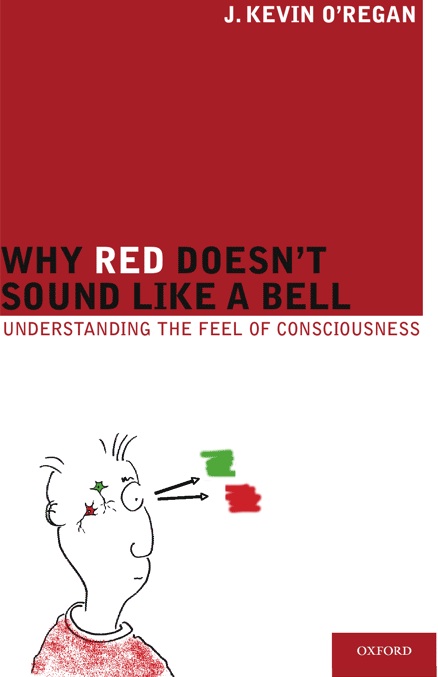 My
book
"Why red doesn't sound like a bell" was published by
Oxford
University Press in 2011, and the final draft is
available to download
in pdf. It suggests a
new way of thinking about consciousness (the
"sensorimotor" approach)
which dispels many confusions, and allows us to explain
the "hardest"
questions about consciousness: namely why sensations
feel like they do
(e.g. why red seems red to us, rather than green, or
rather than
sounding like a bell!), and why sensations have a feel
at all. The
theory is relevant to understanding what would be
necessary for robots
to really feel.
My
book
"Why red doesn't sound like a bell" was published by
Oxford
University Press in 2011, and the final draft is
available to download
in pdf. It suggests a
new way of thinking about consciousness (the
"sensorimotor" approach)
which dispels many confusions, and allows us to explain
the "hardest"
questions about consciousness: namely why sensations
feel like they do
(e.g. why red seems red to us, rather than green, or
rather than
sounding like a bell!), and why sensations have a feel
at all. The
theory is relevant to understanding what would be
necessary for robots
to really feel. My Past Research Interests
After doing my first degree at Sussex University and the first part of my PhD at Cambridge in mathematical physics, I switched my PhD topic to psychology to work on eye movements in reading, and moved to the Centre National de Recherche Scientifique in Paris. My most important early work was the discovery of an "optimal viewing position" for the eye to fixate in words. Recognition is fastest at that position and drops off to either side, making it useful for the eye to fixate there for efficient reading. From this I developed what I called a "strategy-tactics" theory of eye movement control in reading which explains why the eye goes where it does in reading. The idea is that the eye adopts a general strategy of moving a little to the left of the middle of the next longish word, and makes correction tactics as a function of ongoing processing if necessary. The theory is a compromise between the old "rhythm strategy" theory according to which the eye just plods along at a fairly constant rhythm without taking account of what is being read, and the (in the 1970's and 80's) fashionable theory according to which the eye reacts moment by moment, at every instant changing where it goes as a function of ongoing cognitive processing.
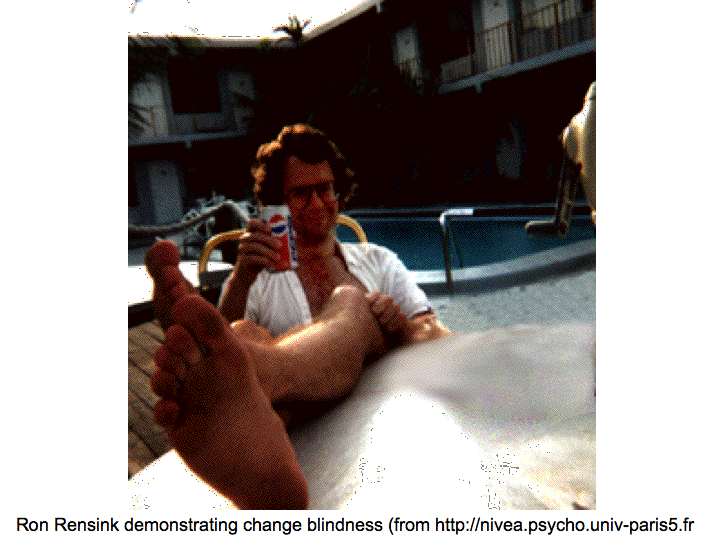 What
I am most cited for is change
blindness,
which I discovered with
collaborators Ron
Rensink and Jim
Clark. Change
blindness is a
phenomenon where a person looks at a picture of a scene,
but doesn't
see enormous changes that occur in that scene when the
changes are
accompanied by a brief interruption like a cinema cut, a
blank, or
even small distractors like
mudsplashes on a car windscreen. You can see
more demos
below. The phenomenon at first seems similar to the
phenomenon of
"inattentional blindness", where
you don't see something that is fully
in view because you are busy attending to something else.
But change
blindness is conceptually a different effect, since it
depends
crucially on the occurrence of a brief transitory event in
the visual
field that distracts your attention, instead of depending
on the fact
that you are consciously attending to
something else.
What
I am most cited for is change
blindness,
which I discovered with
collaborators Ron
Rensink and Jim
Clark. Change
blindness is a
phenomenon where a person looks at a picture of a scene,
but doesn't
see enormous changes that occur in that scene when the
changes are
accompanied by a brief interruption like a cinema cut, a
blank, or
even small distractors like
mudsplashes on a car windscreen. You can see
more demos
below. The phenomenon at first seems similar to the
phenomenon of
"inattentional blindness", where
you don't see something that is fully
in view because you are busy attending to something else.
But change
blindness is conceptually a different effect, since it
depends
crucially on the occurrence of a brief transitory event in
the visual
field that distracts your attention, instead of depending
on the fact
that you are consciously attending to
something else.My Current Research Interests
Today
my main interest is one particular aspect of the problem
of consciousness,
namely the "what it's
like" of sensory experience: why red seems red to us
rather than
seeming, say, green, or like the sound of a bell, or
even like
nothing at all.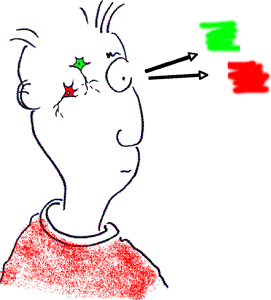
This so-called "phenomenal" aspect of consciousness is considered by philosophers to be the "hard" problem of consciousness, also known as the problem of "qualia". Other questions like the question of why we have selves or why we can become aware of things and use them in our rational actions and thought, are considered not so hard. Most theories of consciousness that neuroscientists talk about concern the second, "easier" form of consciousness. Brain mechanisms like large scale neural integration, feedback, recurrence or synchrony of neural discharges may be able to account for this "easier" type of consciousness. On the other hand, many people think there is a fundamental obstacle in dealing with the "hard" problem of consciousness. There seems to be a kind of "explanatory gap" between the physical mechanisms of the brain and the real, nitty gritty "what it's like" of sensations like red.
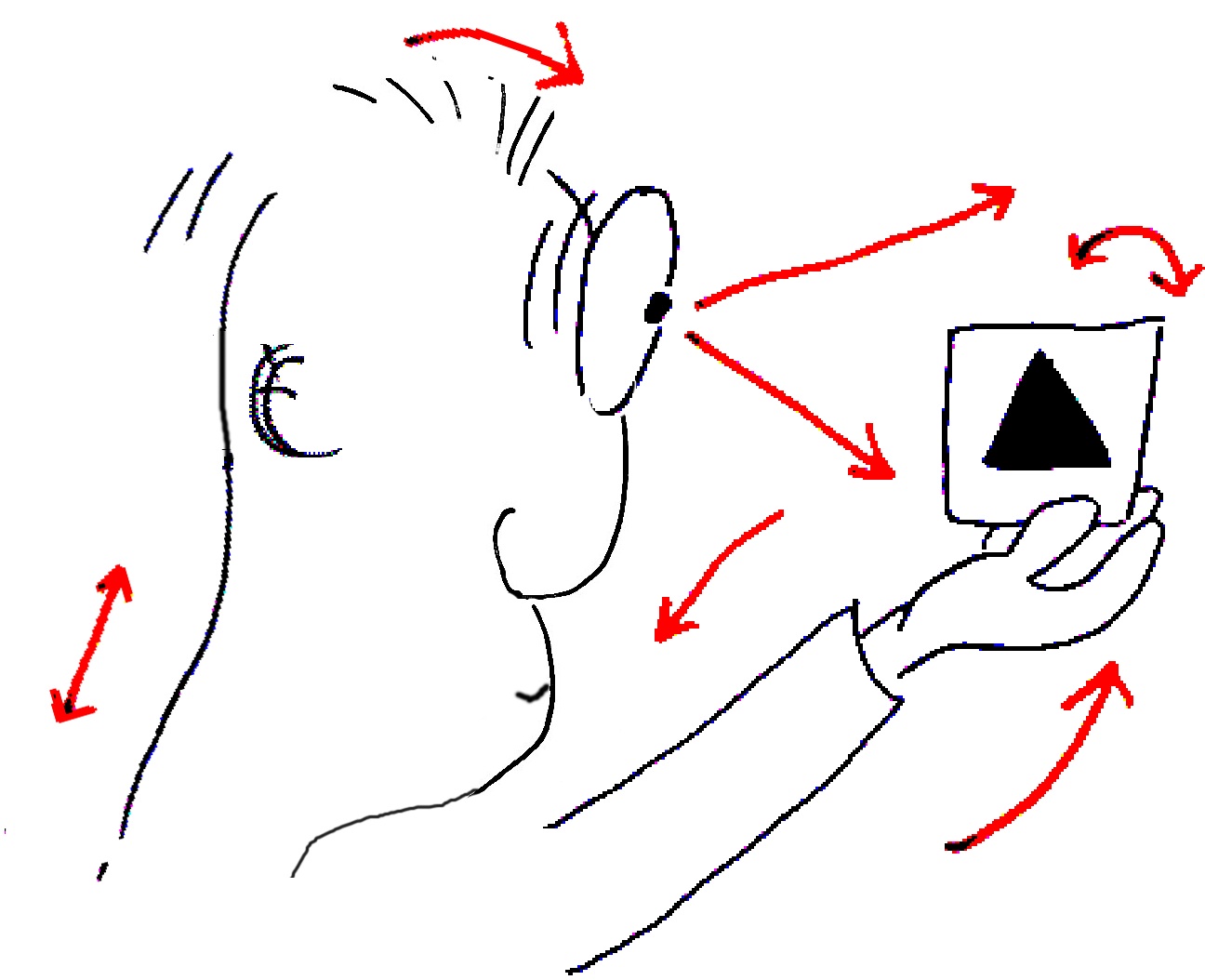 My
work on change
blindness and on eye movements has led me to a new way
of thinking
about the "hard" kind of consciousness. In this, I
consider that the
feel of a sensory experience is not something which is
somehow
generated by the brain,
but is rather a quality of how we interact with our
environment. I have
set
out what I call the "sensorimotor"
theory in various articles, and
have
just finished a book on the subject which should be
appearing in the
next year or so.
The book is for the general public and will
probably have the
title: "Feeling: Why red looks red
rather than sounding like a bell".
My
work on change
blindness and on eye movements has led me to a new way
of thinking
about the "hard" kind of consciousness. In this, I
consider that the
feel of a sensory experience is not something which is
somehow
generated by the brain,
but is rather a quality of how we interact with our
environment. I have
set
out what I call the "sensorimotor"
theory in various articles, and
have
just finished a book on the subject which should be
appearing in the
next year or so.
The book is for the general public and will
probably have the
title: "Feeling: Why red looks red
rather than sounding like a bell".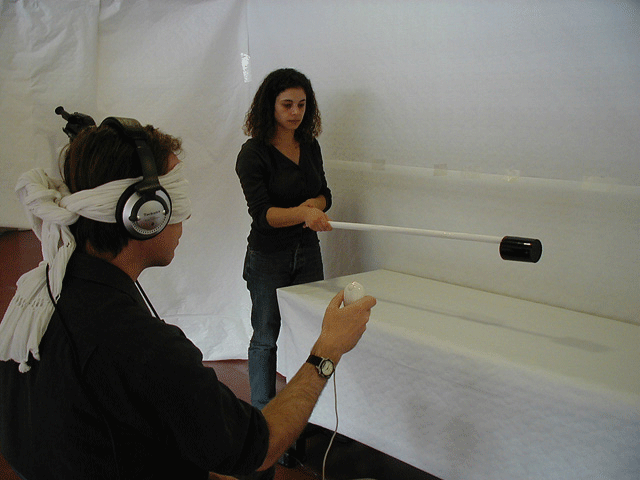 The
new theory makes predictions and suggests breakthroughs in
understanding consciousness which I have
been exploring in the last years. Some of this work
concerns what
is called "sensory
substitution", that is
the possibility of using one
sense (e.g. hearing) to replace another (e.g. vision), and
so, for
example, help the blind to see with their ears. I did this
with Malika Auvray
during her PhD in my lab.
The
new theory makes predictions and suggests breakthroughs in
understanding consciousness which I have
been exploring in the last years. Some of this work
concerns what
is called "sensory
substitution", that is
the possibility of using one
sense (e.g. hearing) to replace another (e.g. vision), and
so, for
example, help the blind to see with their ears. I did this
with Malika Auvray
during her PhD in my lab. 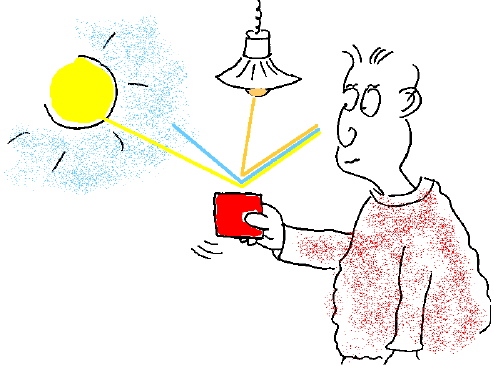 Some
quite
mathematical
work to test the sensorimotor theory was done for his PhD
in my lab by David
Philipona and concerns the nature of
color
and space. David's work on color
is particularly
interesting because it predicts, better than ever before,
well-known
anthropologists' findings about why certain
colors like red and yellow are considered more basic than
colors like
pink and purple. It also explains, better than previously,
exactly
which hues of red, yellow, blue and green seem "pure"
to us.
It
seems to me that this work is getting very close to
answering
the age-old question of why red looks red rather than
green.
David
Philipona's work on space
is also very fundamental and has applications to robotics.
Some
quite
mathematical
work to test the sensorimotor theory was done for his PhD
in my lab by David
Philipona and concerns the nature of
color
and space. David's work on color
is particularly
interesting because it predicts, better than ever before,
well-known
anthropologists' findings about why certain
colors like red and yellow are considered more basic than
colors like
pink and purple. It also explains, better than previously,
exactly
which hues of red, yellow, blue and green seem "pure"
to us.
It
seems to me that this work is getting very close to
answering
the age-old question of why red looks red rather than
green.
David
Philipona's work on space
is also very fundamental and has applications to robotics.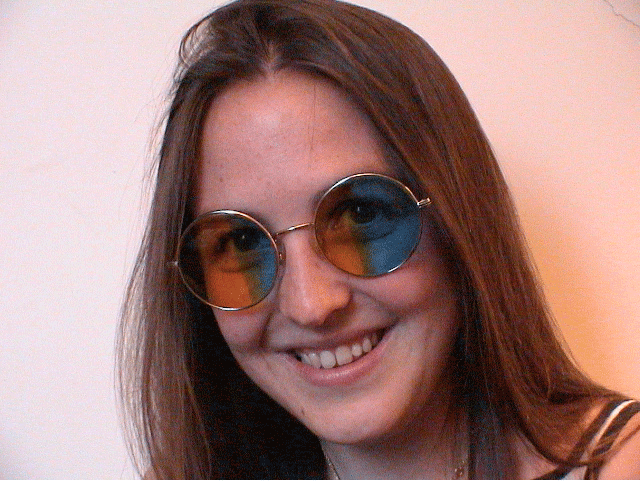
Other work done in my lab to test the sensorimotor theory was done by PhD student Aline Bompas. She confirmed my theory's prediction that the perceived quality of color should depend on eye movements. Finally, most recently with students Ed Cooke and Camila Valenzuela Moguillansky we have been looking at the "rubber hand illusion" and pain.
Papers to read and talks to listen to about the sensorimotor approach
Here is the slideshow of the talk on "How to make a robot that feels" that I gave in Zurich at CogSys 2010 in January 2010. It summarizes the essence of my approach to the problem of phenomenal consciousness, and includes material on the sense of self. And here are the videos (Part 1, Part 2, Part 3) of my talk on "Why red things look red: the sensorimotor approach to phenomenal consciousness" given in September 2009 at the Barcelona Cognition Brain and Technology Summer School.My "magnum opus" is a rather long paper setting out the sensorimotor approach for vision and visual consciousness in the "peer review" journal Behavioral and Brain Sciences, where there were 40 replies from eminent scientists and my responses to them. Philosopher Alva Noë collaborated on the paper, but since then he has continued in a somewhat different, more philosophical direction.
An easy to read introduction to the sensorimotor theory of phenomenal experience is this slideshow, which is an expanded version of a talk I gave at the Association for the Scientific Study of Consciousness in Brussels, June 29-July 2, 2000, and at Bressanone, Jan 21-26, 2001. Another easy paper to read introducing the main ideas of the theory is this, written with Alva Noë.
My recent work supercedes the earlier papers by extending the sensorimotor theory to understanding the "feel" of all types of sensations, not just vision. Several papers on this were written with Erik Myin. This, this, and this are easy to read and introduce the concepts of "bodiliness" and "grabbiness" in order to explain why there is something it's like, rather than nothing it's like, to have a sensory experience.
The sensorimotor theory had its origins in a old paper I wrote which is often cited, and where I claimed that the visual world is like an "outside memory".
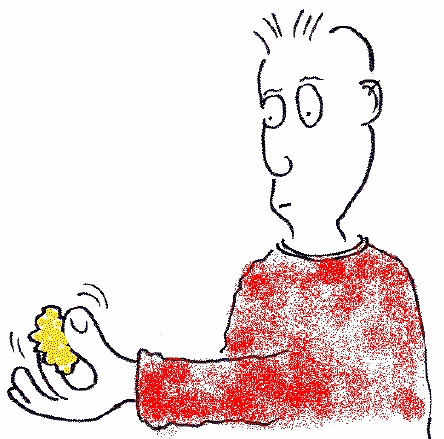
Spongeman's Sensorimotor Manifesto is a wiki for collaborative work attempting to define as precisely as possible the terms used in the sensorimotor approach. Contributions invited! Why "spongeman"? Because in the sensorimotor approach, I use the analogy suggested by my collaborator Erik Myin of squishing a sponge in order to explain the "what it's like" of the feel of softness.
For a selected list of my papers organized by theme, see at the end of this website. For my complete publication list see here.
CHANGE BLINDNESS DEMONSTRATIONS
(Feel free to copy these demos but if you use them in presentations or publications, please be so kind as to credit J. Kevin O'Regan and mention my website http://nivea.psycho.univ-paris5.fr)
Change blindness is a phenomenon in which a very large change in a picture will not be seen by a viewer, if the change is accompanied by a visual disturbance that prevents attention from going to the change location. The easiest way to demonstrate change blindness is to take a picture, and change some object in it. If you view the original and the changed picture in sequence, but with some brief visual disturbance like a blank field or "flicker" in between the original and changed picture, the change sometimes is quite hard to see:
With flicker the change is hard to see
If you take out the blank field however, then the change pops out immediately:
Without flicker the change is easy to see
Instead of using a flicker, it is possible also to use small disturbances like mudsplashes on a car windscreen:
A mudsplash also can mask a big change
You can also get change blindness by making the change so slow that attention is not captured by the changing element, as shown by this animation by my ex-student Renaud Chabrier. As much as 1/4 of the picture changes here:
Change blindness to a very slow change
If the change is part of what is the center of interest of the picture, attention is more likely to go to that part of the picture, and the change is easier to detect, as here:
The change is easy to see if it is part of the "Center of Interest"The change can also be very difficult to detect if it occurs in a film sequence at the moment of a film cut. This is brilliantly shown by an ad by the London Transport Office warning that cyclists can sometimes be very hard to see if you do not happen to be attending to them:
Change Blindness in a film sequence
Daniel Simons at the Beckman Institute in Illinois has made wonderful demonstrations of this kind of thing occurring in real life. Some portion of road traffic accidents may occur because a small, brief distracting event (e.g. a windshield wiper or mudsplash crossing the visual field) masks a change (like a child running into the street).
Here are some more demos of change blindness, of varying degrees of difficulty.
Gunner (mudsplash)Some other change blindness demos:
Flicker and mudsplash demos from Nature article and supplementary info on Change blindness caused by "mudsplashes".
Larger versions of some flicker and mudsplash movies
Change blindness to very slow changes (needs shockwave plugin).
See also the Change Detection Database, and Ron Rensink's demos.
INATTENTIONAL BLINDNESS
Change blindness should be distinguished from "inattentional blindness". Inattentional blindness is a phenomenon in which you are looking at a video sequence or real life event, and your attention is so captured by the task you are doing that something totally obvious, perfectly visible, and in fact, something that you may actually be looking at directly, is not noticed. Transport for London has a demonstration of this on youtube.
This demo is actually a copy of an even more striking "gorilla" demo that was made by Daniel Simons, which itself was based on an experiment performed by Neisser and Becklen. You can find all this and more demos of inattentional blindness on Dan Simons' website, as well as discussion of the issues involved.
Inattentional blindness is at the basis of one of the main causes of road accidents: people "Look but fail to see" (LBFTS) some quite obvious and perfectly visible obstruction in the road.
My collaborator Malika Auvray has made a nice alternative version of Simon's "gorilla" video. You must track the coin and see if you can accurately determine which cup it ends up under. Only after you've done it, read here
Selected Bibliography
Sensorimotor approach:
O'Regan, J.K. (2009).
Sensorimotor approach to (phenomenal) consciousness. In
Baynes, T.,
Cleeremans, A. & Wilken, P. (Eds) Oxford
Companion to
Consciousness. (pp. 588-593). Oxford: Oxford
University
Press. [-] 
Myin, E., & O'Regan,
J.K.
(2008). Situated perception and sensation in vision and
other
modalities: form an active to a sensorimotor account. In
P. Robbins
& A. Aydede (Eds.) (Ed) Cambridge Handbook of
Situated Cognition. (pp. 185-200). Cambridge:
Cambridge
University Press. [OS] 
Myin, E., & O'Regan, J.K. (2007). Phenomenal Consciousness Lite: No Thanks! Behavioral and Brain Sciences, 30, 520-521. [ACL] [IF=12.818]
O'Regan,
J.K., Myin, E., & Noë, A. (2006). Skill, corporality
and
alerting capacity in an account of sensory
consciousness. Progress
in Brain Research, 150, 55-68. [ACL]
[IF=3.253] 
O'Regan,
J.K., Myin, E., & Noë, A. (2005). Phenomenal
consciousness
explained (better) in terms of bodiliness and
grabbiness. Phenomenology
and the Cognitive Sciences, 4(4), 369-387.
[ACL] 
O'Regan,
J.K.,
Myin,
E., & Noë, A. (2004). Towards an Analytic
phenomenology:
the
concepts of "bodiliness" and "grabbiness". In
Carsetti, A. (Eds) Seeing,
thinking and knowing: Meaning and self-organisation
in visual cognition
and thought. Dordrecht: Kluwer. [-] 
Myin,
E.,
& O'Regan, J.K. (2002). Perceptual consciousness,
access to
modality and skill theories: A way to naturalize
phenomenology? Journal
of Consciousness Studies, 9(1), 27-45.
[ACL] [IF=0.918] 
gate io [-]
O'Regan,
J.K.
(2001). The 'feel' of seeing: an interview with J.
Kevin O'Regan. Trends
in Cognitive Sciences, 5(6), 278-279.
[ACL] [IF=10.981] 
O'Regan,
J.K.,
& Noe, A. (2001). A sensorimotor account of vision
and
visual consciousness. Behavioral and Brain
Sciences,
24(5), 939-1031. [ACL] [IF=12.818] 
O'Regan, J.K., & Noë, A. (2001). What it is like to see: A sensorimotor theory of visual experience. Synthèse, 129(1), 79-103. [-] [IF=0.477] html
Noe,
A.,
& O'Regan, J.K. (2000). Perception, attention and
the grand
illusion. Psyche: An Interdisciplinary Journal of
Research on
Consciousness, 6(15), No Pagination
Specified. [-] 
O'Regan,
J.K.
(1992). Solving the "real" mysteries of visual
perception: The
world as an outside memory. Canadian Journal of
Psychology/Revue Canadienne de Psychologie,
46(3),
461-488. [-] html pdf
Change Blindness
Auvray,
M.,
& O'Regan, J.K.
(2003). Influence of semantic factors on blindness to
progressive
changes in visual scenes / L'influence des facteurs
sémantiques sur la
cécité aux changements progressifs dans les scènes
visuelles. L'année
Psychologique, 103(1), 9-32.
[ACL] [IF=0.280] 
Blindness to scene changes caused by "mudsplashes". by J.K. O'Regan, R.A. Rensink, R.A. & J.J. Clark, in Nature, 398, 34, 1999.
Change blindness, by J. K. O'Regan, in Encyclopedia of Cognitive Science, Nature Publishing group, in press.
Perception,
Attention
and the Grand Illusion, by Alva Noë & J. K.
O'Regan
PSYCHE, 6(15), October 2000
Rensink, R.A., O'Regan J.K., & Clark, J.J. To see or not to see: the need for attention to perceive changes in scenes. Psychological Science, 8:368-373. 1997
O'Regan, J.K., Deubel, H., Clark J.J. & Rensink, R..A. Picture changes during blinks: looking without seeing and seeing without looking. Visual Cognition, 7, 1, 191-212, 2000. html
Rensink, R.A., O'Regan, J.K. & Clark, J.J. On the failure to detect changes in scenes across brief interruptions. Visual Cognition, 7, 1, 127-146, 2000. pdf
O'Regan, J.K. Thoughts on Change Blindness. in: L.R.
Harris
& M.
Jenkin (Eds.) Vision and Attention. Springer, 2001, pp.
281-302. view
Nov.
1, 1999 draft.
Color
Philipona,
D.L.,
& O'Regan, J.K. (2006). Color naming, unique hues,
and
hue
cancellation predicted from singularities in
reflection properties. Visual
Neuroscience, 23(3-4), 331-339.
[ACL] [IF=1.411] 
Philipona, D., & O'Regan, J.K. (2008). Reply to
Johnson and Wright. Visual Neuroscience, 25(02),
225-226.
[ACL] [IF=1.411] 
Bompas,
A.,
& O'Regan, J.K. (2006). More evidence for
sensorimotor
adaptation in color perception. Journal of Vision,
6(2), 145-153. [ACL] [IF=2.950] 
Bompas,
A.,
& O'Regan, J.K. (2006). Evidence for a role of
action in
colour perception. Perception, 35(1),
65-78. [ACL] [IF=1.360] 
Space
Philipona,
D.,
O'Regan, J.K., & Nadal, J.-P. (2004). Perception
of the
structure of the physical world using unknown sensors
and effectors. Advances
in Neural Information Processing Systems, 16,
945-952. [-] 
Philipona,
D.,
O'Regan, J.K., & Nadal, J.P. (2003). Is There
Something Out
There? Inferring Space from Sensorimotor Dependencies.
Neural
Computation, 15(9), 2029-2049.
[ACL] [IF=2.378] 
Philipona, D., & O'Regan,
J.K. (2005). Perception multimodale de
l'espace. In Philosophie de la nature aujourd'hui.
Paris: MSH. [OS] 
Philipona, D., & O'Regan,
J.K. (2005). La perception de
l'espace, identification d'une faculté sensorimotrice?
In C.
Thinus-Blanc & J. Bullier (Ed) Agir dans
l'espace.
(pp. 151-165). Paris: MSH. [OS] 
"Filling in" the blind spot, visual qualia, and the theory of the "world as an outside memory"
O'Regan, J.K. Solving the 'real' mysteries of visual perception: The world as an outside memory. Canadian Journal of Psychology, 1992, 46, 461-488. view penultimate draftO'Regan, J.K. The world as an outside memory -- no strong internal metric means no problem of visual acuity. Commentary in Behavioural and Brain Sciences, 1994,17, 270-271.
O'Regan, J.K., No
evidence for neural filling in --
Vision as
an illusion
-- Pinning down "enaction". Commentary on Pessoa,
Thompson &
Noë,
"Finding out about filling in". Brain and Behaviour
Science, 21, 1998
Sensory Substitution
Voir avec les oreilles: Enjeux de la substitution sensorielle. by Auvray, M. & O'Regan, J.K. Pour la Science, 2003
Auvray, M., Hanneton, S., Lenay, C., & O'Regan, J.K. (2005). There is something out there: Distal attribution in sensory substitution, twenty years later. Journal of Integrative Neuroscience, 4(4), 505-521. [ACL]
Lack of translation invariance in vision
Nazir, T.A. & O'Regan, J.K. Some results on translation invariance in the human visual system. Spatial Vision, 1990, 5, 81-100.Reading and "optimal viewing position" in words:
Lévy-Schoen, A., & O'Regan, J.K. Le regard et la lecture. La recherche, 1989, 211, 744-753.O'Regan, J.K. & Jacobs, A.M. Optimal viewing position effect in word recognition: A challenge to current theory. Journal of Experimental Psychology, Human Perception & Performance, 1992, 18, 185-197.
Reilly, R.G. & O'Regan, J.K., Eye movement control during reading: A simulation of some word-targetting strategies. Vision Research, 1998, 38, 303-317.
Nazir, T.A., Jacobs, A.M., & O'Regan, J.K. Letter legibility and visual word recognition. Memory & Cognition, 1998, 26 (4), 810-821. view penultimate draft
Clark, J.J. and O'Regan, J.K., Word Ambiguity and the Optimal Viewing Position in Reading, Vision Research, 1998, 39, 4, 843-857.
Gautier, V., O'Regan J.K. & Le Gargasson, J.-F. "The-skipping" revisited in French : programming saccades to skip the article "les". Vision Research, in press. view penultimate draft
Vitu, F., McConkie,
G.W., Kerr, P. & O'Regan,
J.K.
Fixation location
effects on fixations during reading: an inverted
optimal viewing
position
effect. Vision Research, 2001, 41 , 3513-3533.
Visual illusions
Ninio, J., & O'Regan, J.K. The half-Zöllner illusion. Perception, 1996, 25, 77-94.Read here after having watched Malika Auvray's coin video:
Did you see the green pepper? Look at the video again if you didnt.
